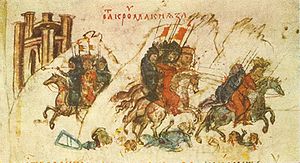| Battle of Pliska | |||||||
|---|---|---|---|---|---|---|---|
| Part of the Byzantine–Bulgarian Wars | |||||||
 The Battle of Pliska, depicted in the 12th century Manasses Chronicle. | |||||||
| |||||||
| Belligerents | |||||||
| Bulgarian Empire | Byzantine Empire | ||||||
| Commanders and leaders | |||||||
| Krum | |||||||
| Strength | |||||||
| 15,000–18,000[1][2] |
22,000[1] 60,000–70,000 (paper strength) 25,000–30,000 (actual strength)[3] | ||||||
| Casualties and losses | |||||||
| Unknown | Most of the army | ||||||
The Battle of Pliska or Battle of Vărbitsa Pass was a series of battles between troops, gathered from all parts of the Byzantine Empire, led by the Emperor Nicephorus I, and the First Bulgarian Empire, governed by Khan Krum. The Byzantines plundered and burned the Bulgar capital Pliska which gave time for the Bulgarians to block passes in the Balkan Mountains that served as exits out of Bulgaria. The final battle took place on 26 July 811, in some of the passes in the eastern part of the Balkans, most probably the Vărbitsa Pass. There, the Bulgarians used the tactics of ambush and surprise night attacks to effectively trap and immobilize the Byzantine army, thus annihilating almost the whole army, including the Emperor. After the battle, Krum encased the skull of Nicephorus in silver, and used it as a cup for drinking. This is one of the most documented instances of the custom of the skull cup.
The Battle of Pliska was one of the worst defeats in Byzantine history. It deterred Byzantine rulers from sending their troops north of the Balkans for more than 150 years afterwards, which increased the influence and spread of the Bulgarians to the west and south of the Balkan Peninsula, resulting in a great territorial enlargement of the First Bulgarian Empire.